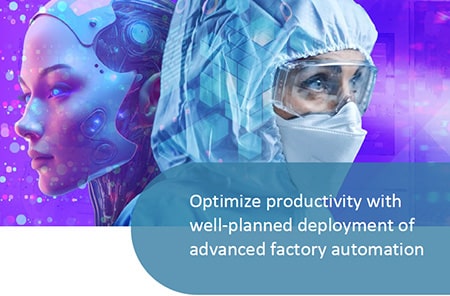AI’s paradigm shift
Proven technology, fresh disruption
Artificial intelligence is not new or revolutionary when you consider that the term AI was coined in the ’50s. What is new is the mainstream application of and accessibility to AI, enabled by the development of software and advanced processing power to support it. This has paved the way for a particularly disruptive force in the rapidly evolving human understanding of how to use AI—and this is completely changing the landscape. It is increasing performance levels and creating new business opportunities.
For manufacturers, the AI revolution is the ability to bring technologies to market at a much faster rate than ever before. Whereas once a business might have the ability to design something and put it into their production line in nine months, AI could enable them to do so in a game-changing three. This ability to focus on more advanced products, more cost-effectively, and with gains in quality and throughput, can significantly change a business. This includes creating opportunities to pursue high margin contracts previously beyond reach.
In the semiconductor industry, for example, there are only a few companies capable of introducing innovative, improved products to the market; they enjoy remarkable margins on those products for a period of time. With AI, companies not previously able to compete in this way will be able to leapfrog one or two generations forward and perform at higher levels.
The data needed to teach AI systems is also changing. Once considered only possible for the large players that have access to vast oceans of data, new techniques in generating synthetic data are helping bridge the gap. We will see a focus on the ability to bridge the understanding between different products in the factory. Product changeover will become more seamless and will allow us to manage the variance more effectively. This, in turn, will profoundly improve the ability to manage line variance. With the technological advancements surrounding AI, the next step in the revolution is learning how to implement it in a repeatable, scalable and meaningful way.
The human element
As much as AI is a technological innovation, it’s the human component that will help it realize its potential and drive the new paradigms. Currently, the skillset needed to fully optimize AI is shared by two different groups of people, the data science experts who are familiar with AI and related technologies, and the process experts who thoroughly understand semiconductor manufacturing. They will need to collaborate to maximize AI’s impact and the methods by which models are trained for specific applications.
Manufacturers also will use AI to overcome human limitations. For example, AI can be tasked with running 16 analyses simultaneously and will derive a response within seconds. Conversely, a human is prone to fatigue and bias that may lead to missteps, takes much longer to process these analyses, and will inherently add their own interpretation to the result.
Another way AI will improve upon human limitations is around retention. While memory, training and experience variations in humans result in each person addressing a problem or learning information differently, AI is an effective alternative. The difference between how AI and people work with information is the way that learning can be captured, resulting in unified understanding across the board and the ability to associate all the data sets required in real time.
AI can also address the challenge of knowledge retention in manufacturing, especially as experienced workers retire and new ones enter the workforce. Knowledge retained by AI can be instantly available across the factory to help mentor incoming talent. We can essentially build a learning system. That’s new!
Economic considerations
The integration of AI in manufacturing is influenced by economic factors as much as it is by technological and human factors. A 300mm foundry that’s doing advanced nodes, a 200mm automotive manufacturer and a 150mm MEMS factory each have a different business outlook. Their structures are different and their willingness and need to spend is driven by something entirely different from one another. For instance, the 150mm factory has significant margins, but needs a compelling reason to change something or invest in something. They must be able to get meaningful results that will change their business or there is no incentive for them to invest in AI. These types of factories will invest in efficiency gains.
Instead, AI integration will be developed at the 300mm manufacturing level. While that’s not a hard rule, it would be difficult to envision a major spend in a legacy factory (I have been surprised before). AI is going to play a huge role in the high mix, low volume scenarios and will be incredibly powerful bringing new products to market.
One of the things semiconductor manufacturers are most concerned about is the aging population that’s retiring and the experience that will walk out the door with them. They’re worried about how to manage things like potentially catastrophic events that only happen once every three years or so when the only people who have ever experienced them are gone. AI is going to help bridge that gap, to retain knowledge and make it available for the newer workers. It will also help companies teach people their trade more efficiently. This is among the most meaningful reasons manufacturers will have for investing in AI.
Ultimately, the economic decision around AI will move over time based on the economics of the factory and the market forces on it.


